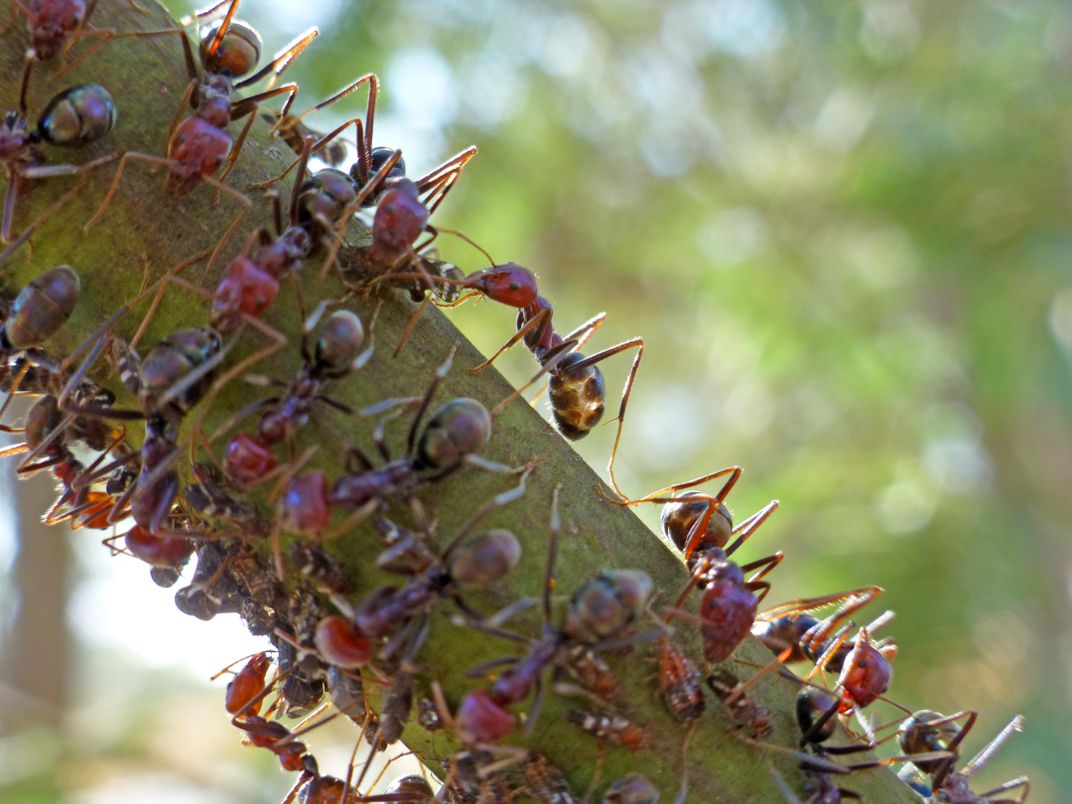Antennae Yield New Clues Into Ant Communication
Despite more than a century of study, scientists still have much more to learn about the complex world of ant communication
/https://tf-cmsv2-smithsonianmag-media.s3.amazonaws.com/filer/4d/35/4d35e04f-2656-460c-85d3-89a0f493207f/sebastian_pohl.jpeg)
On August 12, 1886, Swiss scientist Auguste Forel methodically plucked the antennae from the heads of scores of ants of different species. While such an act might be something more expected of a mean little boy than a scientist, it would lead to an amazing insight about how ants communicate.
When Forel placed all of his ants together in a box—an act that, with intact critters, would inspire displays of aggression—the antennae-less creatures coexisted in harmony. “Little by little my various ants huddled themselves happily together,” Forel wrote in The Senses of Insects. This little patch of ant paradise had demonstrated a concept still central to scientists’ understanding of ant communication today: Ants use their antennae to sort out friend from foe.
Yet over a century later, the details behind this silent communication largely remain a mystery. But a study published today in the Proceedings of the Royal Society B may help researchers sort through the complexities of ant “language.” It suggests that, like dogs sniffing one another’s behinds, ants home in on foreigner’s antennae to pick up important chemical cues.
Many years after Forel’s experiment, scientists realized that the antennae-less ants were no longer sensing a group of compounds called cuticular hydrocarbons, or CHCs. This greasy or waxy substance covers the entire body of most insects to prevent them from drying out, similar to the wax on the leaves of many plants.
CHCs are a very diverse group of compounds. And an ant won’t be covered by just one CHC but many. The combination of CHCs may differ across ant colonies or even within a single nest. Other creatures have even learned to mimic these scents to gain access to an ant fortress.
Until now, scientists had assumed that for each individual ant, the CHC coating was uniform over the entire insect. But that isn’t necessarily the case, says Qike Wang, a graduate student at the University of Melbourne and lead author of the new study.
In many animals, parts of the body attain quite distinct, and sometimes potent, odors from excretions of different glands as well as environmental factors. Wang notes, “Your armpit smells different than your foot, right?” Yet no one had previously questioned this idea for ants.
So Wang and his colleagues analyzed the profile of CHCs on the antennae, head, legs and abdomen of ants from the worker and reproductive castes of Iridomyrmex purpureus meat ants from Australia. They found that the the odors can differ more across a single ant’s body parts than between different colonies.

With such great variation in scent, the team wondered how ants might be using the various cues to identify nestmates. So they watched how pairs of worker ants interacted when presented with nestmates and non-nestmates. The ants showed more interest in using their sensitive antennae to probe their opponent’s antennae, rather than the other ant’s back or legs—giving researchers a whiff of the organ’s unidentified importance.
The researchers then repeated a version of Forel’s experiment, but they only removed the antennae from some of the ants. They presented those ants first with nestmates and then with non-nestmates. Even with their antennae intact, the assumed opponents showed no aggression toward the antennae-less creatures.
But it was hard to know the other effects of antennae amputation on the creatures. So Wang and his colleagues tested the ants again but this time only removed the waxy CHC coating from the antennae.
To accomplish this tricky task, the researchers anesthetized the ants by briefly placing them in a freezer. Then, they delicately dipped the ant’s antennae in an organic solvent that striped away the waxy coating.
When the ants woke up, the team presented them to nestmates and non-nestmates to watch their reaction. The insects showed few signs of aggression to the cleaned ant, which often showed aggression to the still CHC-laden insects.
The team repeated the experiment again and again. The results all suggested that ants pick up their cues to identify nestmates using only the CHCs on the antennae—a hint that there is a great deal more complexity to ant communication that researchers may have missed.
“For such a long time, we took it for granted that antennae are just sensory organs and didn’t think of other functions,” Wang says. But it appears that the antennae are conveying as well as receiving information.
“There’s been a trend towards understanding that the odor profiles of individuals in a colony are much more diverse than we imagined,” says Deborah Gordon, a biologist at Stanford University who was not involved in this research. "This [study] is taking that a step further by showing that odors are different even within an individual."
So where are these odorous cues coming from?
At this point, it’s tough to say. Scientists previously thought that ants spread CHCs while they groomed themselves or others or perhaps shared odors when they bumped into one another in the bustling colonies. Recent studies, however, have suggested that many other factors can also change these chemical cues, Gordon says. For harvester ants, the foragers toil for long hours in the sun, which can transform their CHC coating, imparting them with a distinct odor compared with their nest-bound mates.
"It's a really interesting discovery and raises a lot of questions," says Gordon. "Like, where does the variation come from? How does it change over time?"
Wang and his colleagues have now turned to these questions to see if they can parse where the different cues are coming from and what information ants glean from the scents.
Even after more than a century of scientific probing, Wang remains hopeful that scientists will eventually crack ant communication. “Even in these areas that are so well-studied and so well-known, nature can still surprise us,” he says.
/https://tf-cmsv2-smithsonianmag-media.s3.amazonaws.com/accounts/headshot/Wei-Haas_Maya_Headshot-v2.png)
/https://tf-cmsv2-smithsonianmag-media.s3.amazonaws.com/accounts/headshot/Wei-Haas_Maya_Headshot-v2.png)